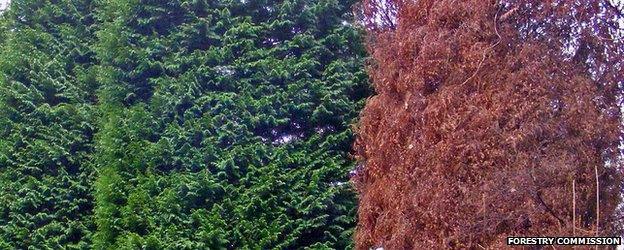UK government launches tree biosecurity plan
- Published

Historically, the disease Phytophthora lateralis has been known to affect trees in western US and Canada
The UK government has said that it will invest £7m to tackle tree diseases, amid fears that millions of trees could be lost unless urgent action is taken.
The Tree Health and Plant Biosecurity action plan, external was launched as scientists confirmed the arrival of a deadly disease in England among urban trees.
Phytophtora lateralis, external was recorded in Devon on a Lawson cypress, a popular species in parks and gardens.
Ministers hope the plan will tighten biosecurity measures and protect trees.
"If we don't act now, we could end up with a similar situation to the 1970s when more than 30 million trees in the UK died [as a result of] Dutch elm disease," said Environment Secretary Caroline Spelman as she launched the action plan.
"There are new diseases and new threats now, and we need to do everything we can to protect our precious plants, trees and habitats.
"[The] action plan dedicates £7m to finding ways to combat exotic pests and diseases, as well as introducing stricter controls on plants and cuttings being brought across the UK's borders."
However, the funding is not new money from the Treasury. It is funding from within Defra's existing science budget that will be allocated to tree health and biosecurity research.
A spokesperson for the Department of Environment, Food and Rural Affairs (Defra) said: "More research into tree health is needed if we are to protect our trees from disease.
"We have allocated £7m over the next three years from existing resources to carry out this vital research."
It is understood that £2m will be made available in the first year, and £2.5m in years two and three.
The Woodland Trust welcomed the news, but said reallocated rather than new funding did raise questions about the government's description of the issue as a "top priority".
"Without measurable goals for this plan, it is impossible to say whether this amount of money is enough to achieve the proposed benefits that are broadly outlined," said Hilary Allison, policy director for the Trust.
"So, for the trees and forests sector as a whole to have confidence in this document, we need to have sight of the detail which underpins these very broad statements."
Recently, one of the UK's leading tree ecology experts - Dr Keith Kirby from Natural England - warned that the risk from pests and diseases facing the nation's oaks had left the species' future "at a crossroads".
The action plans sets out ways a number of measures to help protect trees in the future, including:
minimising the risk of new threats entering the UK
learn more about the current threats within the UK
improve awareness among people of the current array of pest and diseases
Improve surveillance
William Worsley, president of the Country Land and Business Association (CLA), welcomed the announcement of extra funding.
"Improving the channels for reporting and monitoring new pests and diseases will help tree owners detect poor tree health early on so it is managed effectively," he said.
"The intention to tighten import controls on plant materials, and working more closely with European partners, is also welcome news."
'Woefully underfunded'
Mr Worsley went on to say that he hoped that much of the additional £7m would be allocated to Forest Research, the scientific arm of the Forestry Commission.
"It is an organisation that is highly respected by the forestry sector and best placed to respond to the challenges ahead concerning tree health," he added.
Pam Warhurst, chairwoman of the Forestry Commission, said that there were "few more urgent issues" within the sector, and hoped the launch of the action plan would allow them to "get on and do what needs to be done".
"It's important that we are prepared for new threats," she observed, "so we particularly welcome the £7m extra funding for research into tree health over the next three years."
Shortly after the launch, scientists from the Forestry Commission confirmed that the first outbreak of Phytophthora lateralis had been recorded in England.
Researchers said the disease, which attacks susceptible trees' root systems, had been identified to be affecting several Lawson cypress (Chamaecyparis lawsoniana) in a shelter hedge on an industrial estate in Plymouth, South-West England.
Although the species is a popular plant within the horticultural trade, it is listed as Vulnerable in the wild, external. Its native range is along the costal regions of western Canada and the US, and that is believed to be the source of P. lateralis, which has spread across the Atlantic Ocean.
Previous cases have been recorded in Scotland and Northern Ireland, as well as other locations within mainland Europe. However, John Morgan, head of plant health for the Forestry Commission, said the latest news was a worrying development.
"We are working hard with colleagues in [the Food and Environment Research Agency] to contain the disease quickly and try and trace where it came from," he explained.
"Our surveillance teams are actively looking for signs of the disease during helicopter surveys."
He called for land owners to be extra vigilant for signs of the disease as researchers were expecting to find more cases.
He warned: "If the disease becomes established it could also be very serious for the ornamental plant industry because Lawson cypress - and its various colourful varieties - is one of the most important conifers in the ornamental plant trade."
- Published2 August 2011